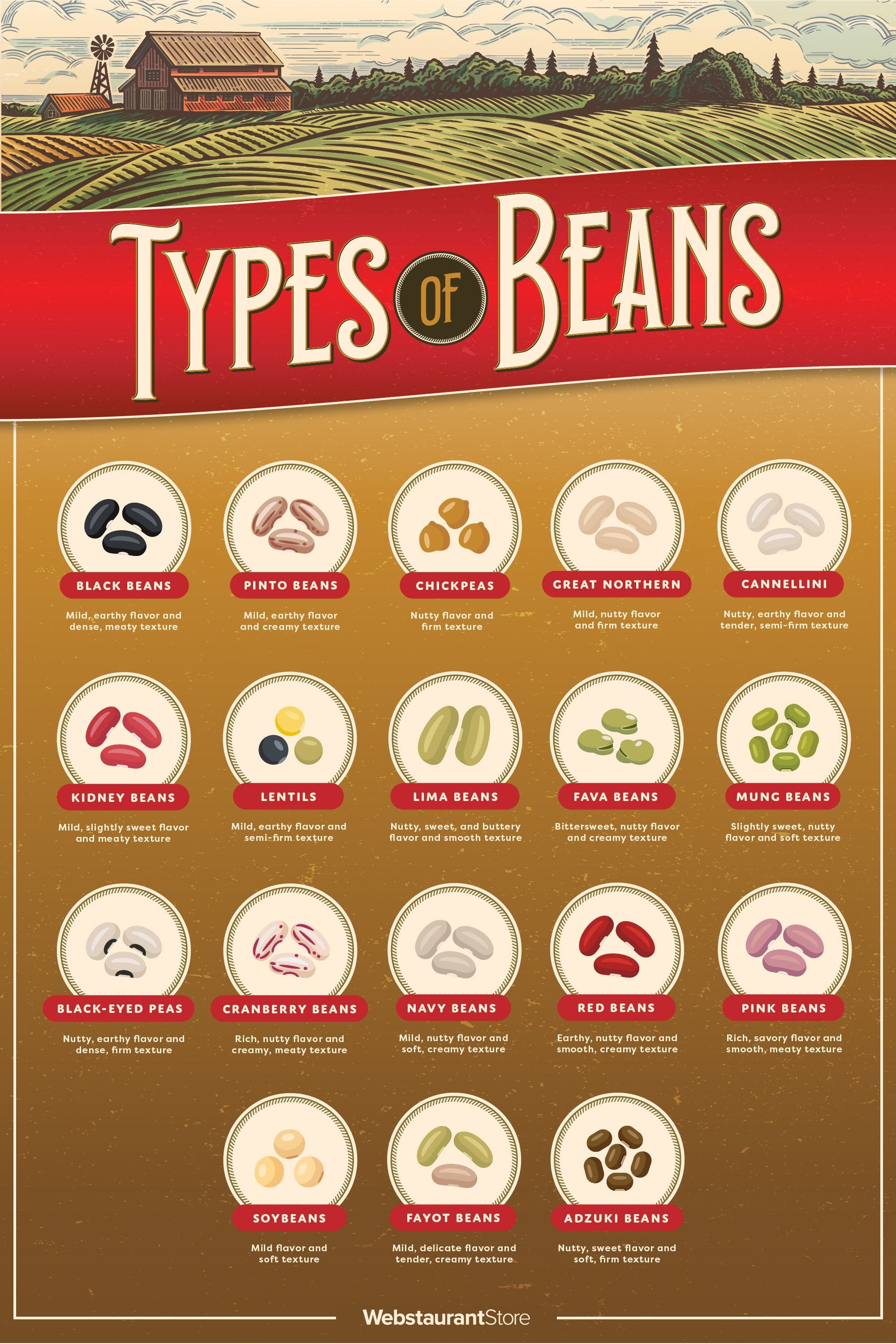
Types of Beans
Beans are a cost-effective, plant-based protein, which has made them a staple food in diets across the world for centuries. Each type of bean has its own taste, texture, and unique properties that make them great for a wide variety of applications. Plus, beans are naturally vegan-friendly, making them an easy way to accommodate vegans and vegetarians at your restaurant. We've listed the different bean types and how they differ so you can choose the best beans for your next recipe.
Shop All Bulk Beans
Use the following links to explore the types of beans out there, so you can make more informed purchases for your menu!
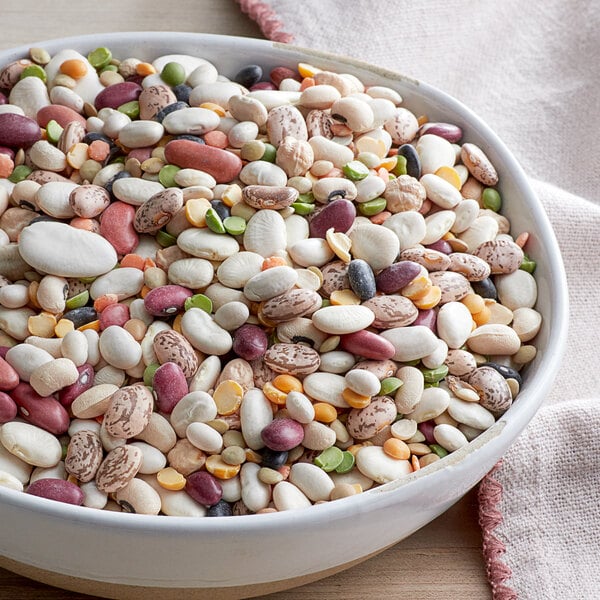
Beans are a type of legume, along with peas and peanuts, that grow from flowering plants in the Fabaceae family. The beans are edible seeds that grow within pods from the plant, which are then harvested, dried, and sold for consumption. Beans are a nutritionally dense addition to your diet for their high protein and fiber content and abundance of essential vitamins and nutrients.
Beans are either sold in dried form, which requires soaking prior to cooking, or they are conveniently pre-cooked and canned to eliminate prep work. It's important to note that many dried beans, like kidney and cannellini beans, are not safe to eat raw and must be cooked before consumption to eliminate the toxic lectins that can cause digestive issues.
Beans are extremely versatile in application and can be used in a wide variety of dishes. Take a look at these 18 common types of beans to determine which flavor profile and texture will work best for your next recipe.
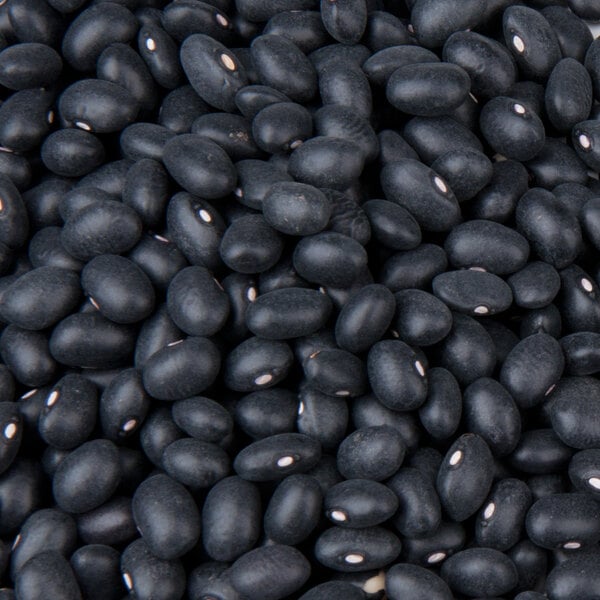
1. Black Beans
Black beans are small, oval-shaped beans that are native to South and Central America. They are a staple in many South American, Mexican, Spanish, and Caribbean dishes. Black beans are popular in burritos, enchiladas, and chilis, or served as a side with rice. The dense yet smooth texture and high protein content of black beans make them an excellent meat substitute, and they are commonly used as a substitution for traditional burgers.
Black Bean Flavor: Mild and earthy
Black Bean Texture: Dense and meaty
Black Bean Uses: Soups, stews, salads, salsa, dips, and vegan burgers
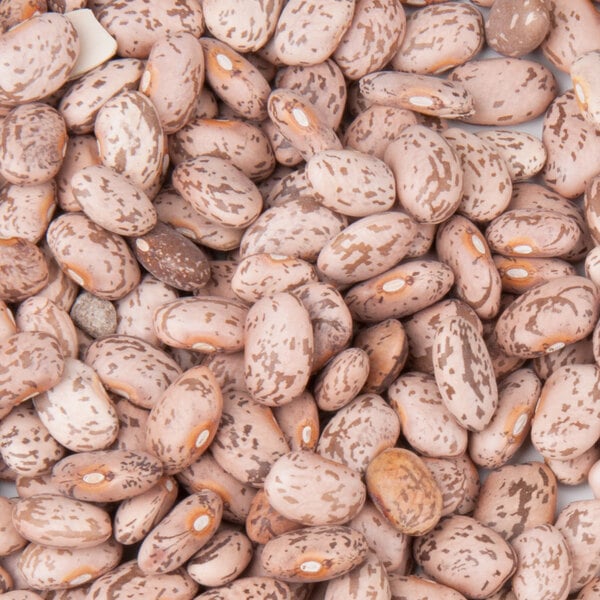
2. Pinto Beans
Pinto beans are medium, oval-shaped beans that are light brown in color with dark brown specks that disappear when cooked. Native to South and Central America, pinto beans are a staple in many Southwestern American and Latin American dishes and are the most commonly consumed bean in the United States. Pinto beans are popular in refried beans, chilis, burritos, or enchiladas, or served as a side with rice. Since they both pair well with the same types of herbs and spices, pinto beans and black beans can be swapped out for each other in a variety of recipes.
Pinto Bean Flavor: Nutty and earthy
Pinto Bean Texture: Soft and creamy
Pinto Bean Uses: Refried beans, soups, stews, salads, casseroles, and dips
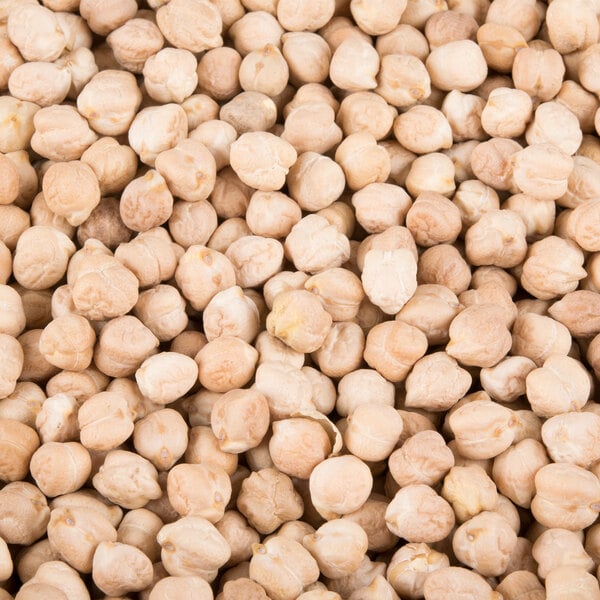
3. Chickpeas
Chickpeas, or garbanzo beans, are medium-sized, round, white beans that are a staple in many Indian, Middle Eastern, Mediterranean, and Spanish dishes. Providing an unlimited number of ways to be used in recipes, chickpeas are popularly used in hummus, a variety of vegetarian meals, and aquafaba, which is made from chickpea water and is used as an egg substitute in vegan and allergen-free recipes. Dried chickpeas are also commonly roasted with oil and seasonings for a healthy snack.
Chickpea Flavor: Nutty and earthy
Chickpea Texture: Firm and grainy
Chickpea Uses: Hummus, falafel, curries, salads, soups, stews, and vegan burgers
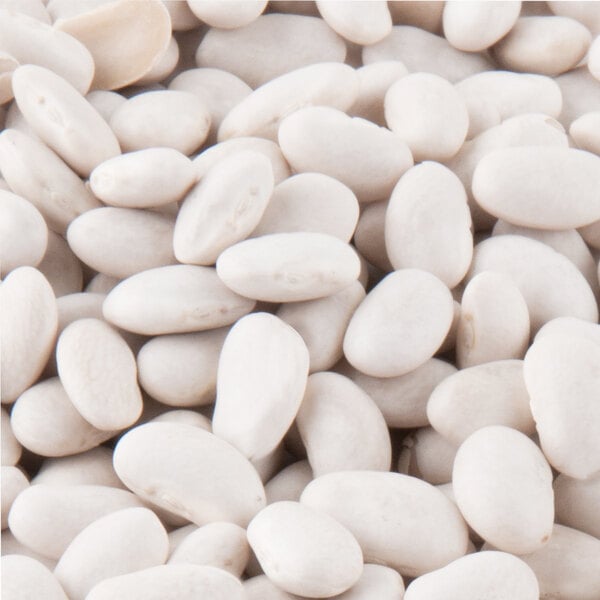
4. Great Northern Beans
Great northern beans are medium-sized, oval-shaped white beans that are native to Central and South America. Popular in North American dishes, they are great at absorbing the flavors they are cooked with and hold their shape well. Great northern beans are a great choice for purees, soups, chilis, and baked beans. They are also popularly used to make a full English breakfast.
Great Northern Bean Flavor: Mild and nutty
Great Northern Bean Texture: Soft and creamy
Great Northern Bean Uses: Baked beans, soups, stews, dips, and casseroles

5. Cannellini Beans
Cannellini beans, or white kidney beans, are large, kidney-shaped white beans. Though they are native to Argentina, cannellini beans are a staple in Italian and American dishes. Versatile in application, they are popular for adding to pasta dishes, stews, ragout, and salads. They are also commonly found in white bean soups and minestrone soup.
Cannellini Bean Flavor: Nutty and earthy
Cannellini Bean Texture: Tender and semi-firm
Cannellini Bean Uses: Pasta, casseroles, soups, stews, salads, and chilis
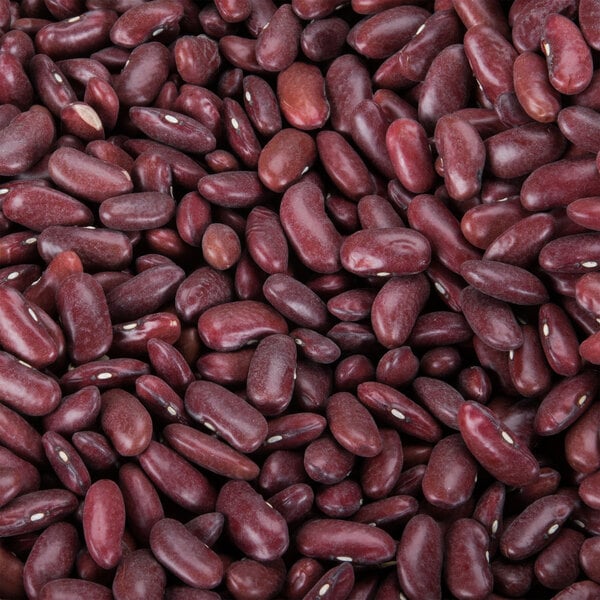
6. Kidney Beans
Native to Central America, kidney beans feature a vibrant red skin and white interior and a kidney-like shape, which is where the bean gets its name from. Red kidney beans are not to be confused with red beans, which are smaller in size and creamier in texture. They are popular in American, Italian, Creole, and Indian dishes and hold their shape during cooking, which makes them a common choice for use in chilis, soups, stews, and other simmered dishes.
Kidney Bean Flavor: Mild, slightly sweet flavor
Kidney Bean Texture: Firm and meaty
Kidney Bean Uses: Chilis, soups, stews, and dips
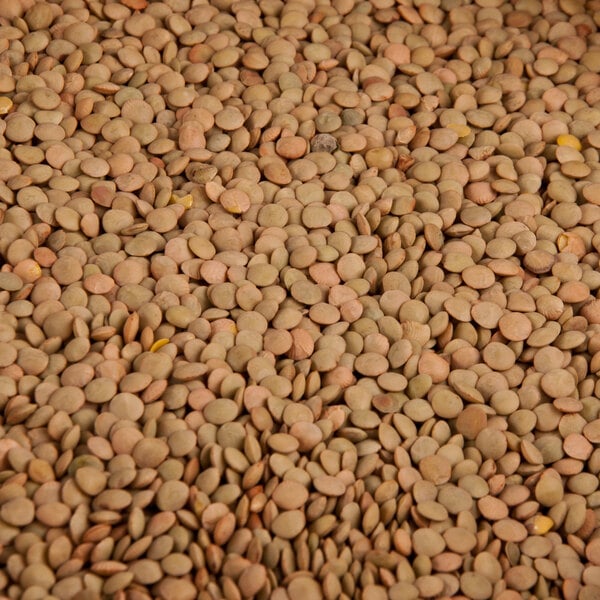
7. Lentils
Lentils feature a distinctive, small, disc shape and come in brown, green, red, yellow, and specialty varieties. They are a staple in Indian and Middle Eastern dishes, including the popular mujadara and masoor dal tadka entrees, and are commonly used in stews, soups, and curries. They have a high protein content, which makes them great for use as a meat substitute in vegetarian meals. Plus, lentils can be milled into flour and used to make gluten-free pasta and bread.
Lentil Flavor: Mild and earthy
Lentil Texture: Tender and semi-firm
Lentil Uses: Soups, stews, curries, dal, and vegan burgers
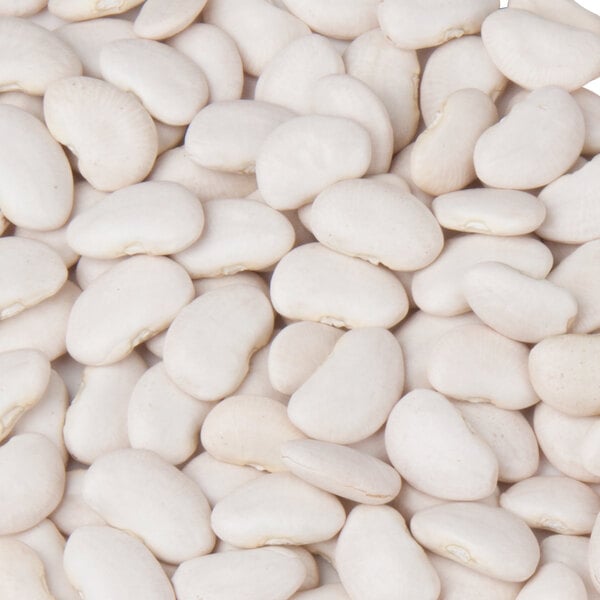
8. Lima Beans
Lima beans are named after the capital city of Peru, its native country of origin. They come in either a small or large size, and their color ranges from green to white based on their maturity. Lima beans are also commonly called butter beans for their buttery, rich flavor, and velvety texture. Popular in Southern American dishes, lima beans are the main ingredient in a classic succotash and are common to add to casseroles, soups, or simmered with pork to serve as a savory side dish.
Lima Bean Flavor: Nutty, sweet, and buttery
Lima Bean Texture: Smooth and creamy
Lima Bean Uses: Succastash, soups, stews, casseroles
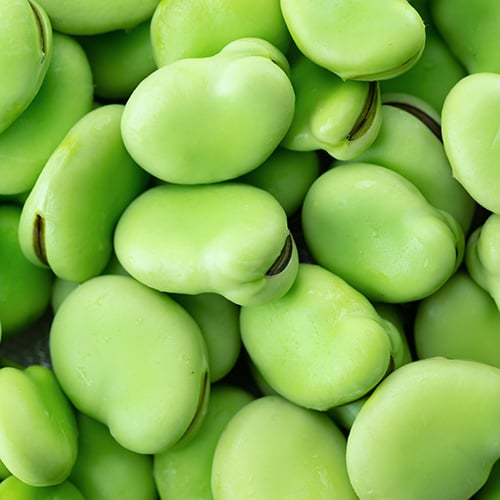
9. Fava Beans
Fava beans, or broad beans, are usually sold fresh in their green pods. The bean itself is large, flat, and green with a tough, clear skin that is typically removed before cooking. To do this, you should remove the seeds from their pods, blanch them, and then remove the skins before continuing to cook. Popular in Middle Eastern, Mediterranean, and South American cuisines, fava beans are perfect for adding to soups and stews, bean salads, and mashing or pureeing for spreads and dips.
Fava Bean Flavor: Bittersweet and nutty
Fava Bean Texture: Tender and creamy
Fava Bean Uses: Soups, stews, salads, dips, and spreads
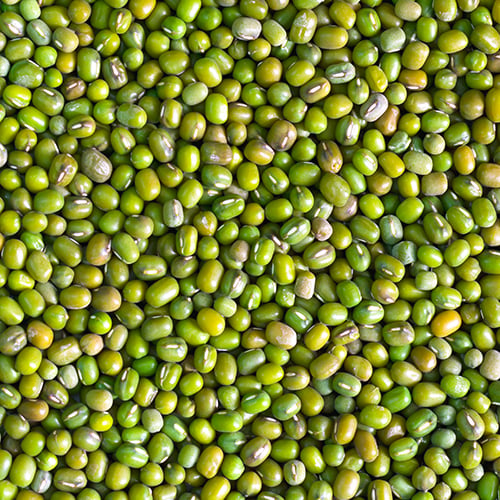
10. Mung Beans
Mung beans are small, round, and green and are a staple in Chinese, Indian, and Southeast Asian cooking. Their slightly sweet flavor and soft texture make them great for use as an ingredient in a variety of desserts like puddings, sweet soups, and cakes. Mung beans are a common alternative to chickpeas in recipes, making them a popular choice for adding to soups, stews, and curries, mashing to make fritters and falafels, or roasting with seasonings for a healthy snack.
Mung Bean Flavor: Slightly sweet and nutty
Mung Bean Texture: Soft
Mung Bean Uses: Soups, stews, curries, and desserts

11. Black-Eyed Peas
Black-eyed peas, also called cowpeas, have a small, round, white body with a distinctive black spot called an "eye". Native to North Africa, they are a staple ingredient in North African, Southern American, and Indian dishes. Compared to green peas, which have a sweet taste and soft texture, blackeye peas have a richer flavor and denser, meatier texture that stands up well to long cook times and bold flavors.
Black-Eyed Pea Flavor: Nutty and earthy
Black-Eyed Pea Texture: Dense and firm
Black-Eyed Pea Uses: Soups, stews, curries, salads, and side dishes
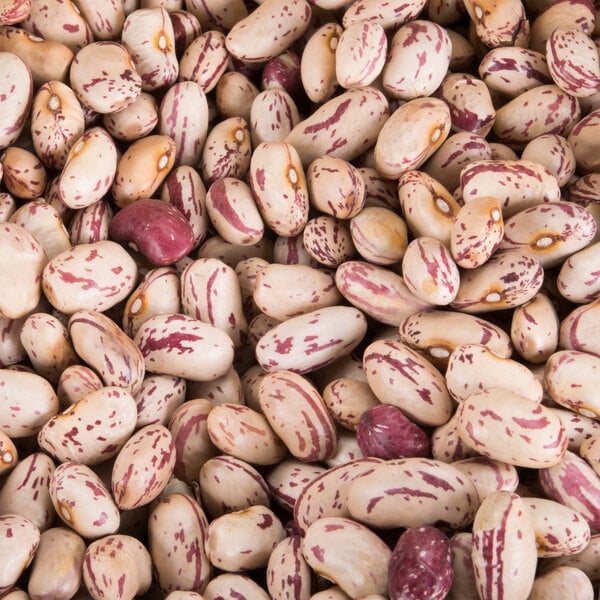
12. Cranberry Beans
Cranberry beans, also known as borlotti beans, are medium, oval-shaped beans that are beige-pink in color with dark red specks that fade when cooked. Native to Colombia, cranberry beans are commonly used in Italian and Portuguese cuisines. They develop a creamy texture when cooked and their thin skin makes for a delicious bean broth, which makes them a popular addition to minestrone, pasta e fagioli, and Portuguese beans.
Cranberry Bean Flavor: Rich and nutty
Cranberry Bean Texture: Creamy and meaty
Cranberry Bean Uses: Soups, stews, ragouts, and casseroles
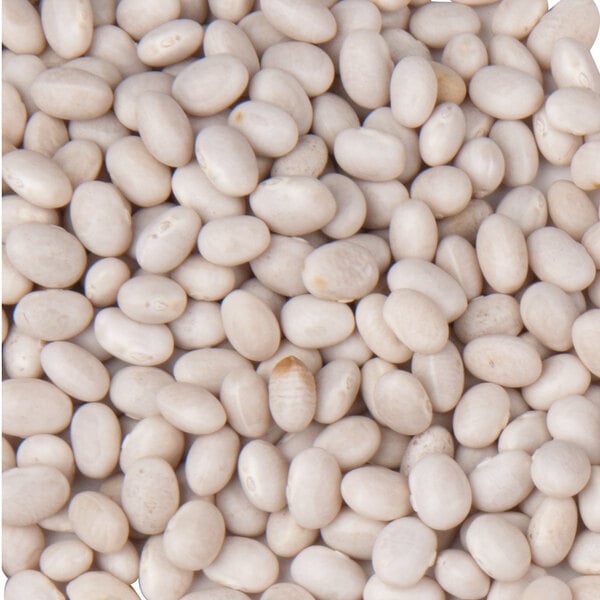
13. Navy Beans
Navy beans, or white pea beans, are small, oval-shaped white beans that are native to the Americas. The navy bean name comes from its use as a staple food in the U.S. Navy in the mid-1800s due to being cost-effective yet nutritionally rich. Navy beans are great at absorbing the flavors they are cooked with, making them a popular choice for white bean dips, chilis, pasta, and burgers. They are used in a variety of popular American dishes like Boston baked beans, Kansas City-style BBQ baked beans, and Senate Bean Soup.
Navy Bean Flavor: Mild and nutty
Navy Bean Texture: Soft and creamy
Navy Bean Uses: Baked beans, soups, stews, salads, casseroles, and dips

14. Red Beans
Red beans are small, oval-shaped beans that are bright red in color. They are a staple in Caribbean, Latin American, Creole, and Cajun dishes, and are most notable for the classic Cajun red beans and rice dish. They are ideal for use in soups, stews, chilis, or as a side dish with smoked sausage or ham hock.
Red Bean Flavor: Earthy and nutty
Red Bean Texture: Smooth and creamy
Red Bean Uses: Soups, stews, chilis, and side dishes
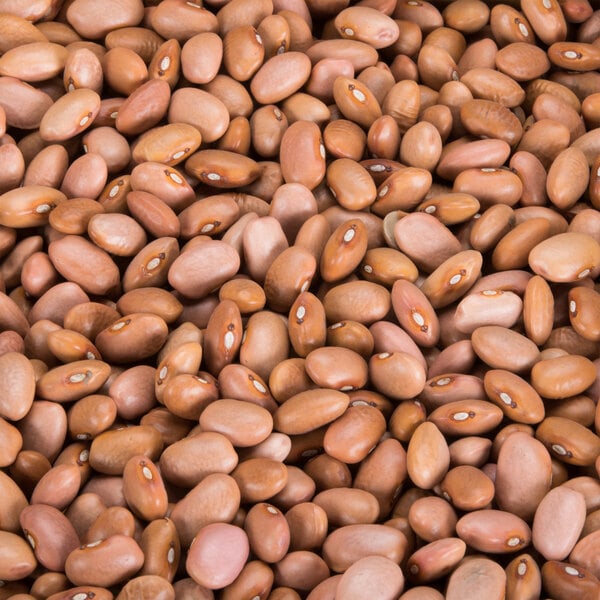
15. Pink Beans
Pink beans, which get their name from their pink color, are medium, oval-shaped beans. They are an essential ingredient in many Caribbean and Latin dishes including pink beans and rice and habichuelas guisadas. Pink beans are also a favorite for barbecue-style dishes, baked beans, chilis, and refried beans. Due to their similar texture, pink beans can be used interchangeably with pinto beans.
Pink Bean Flavor: Rich and savory
Pink Bean Texture: Smooth and meaty
Pink Bean Uses: Stews, side dishes, chilis, and refried beans

16. Soybeans
Soybeans are tan, round beans that are native to China and are now heavily produced in the U.S. Soybeans are used to make a variety of plant-based meat substitutes, including tofu, tempeh, and yuba. They are also commonly used to make sauces, vegetable oils, and even non-consumable products like candles and biodiesel fuel. Edamame is green, immature soybeans that have a sweet taste and are commonly added to soups, stir-fries, rice dishes, and side dishes.
Soybean Flavor: Mild
Soybean Texture: Soft
Soybean Uses: Vegan dishes, soy sauce, miso, vegetable oil, soups, and stews
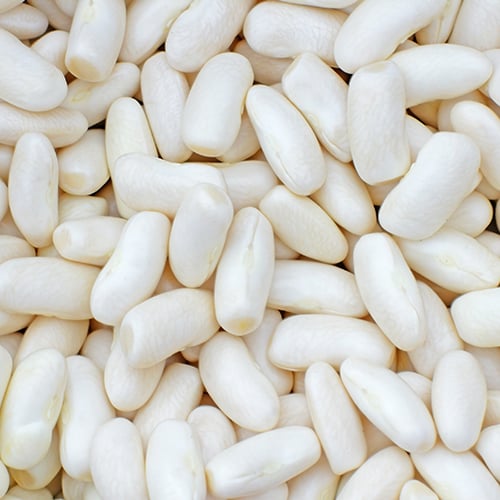
17. Fayot Beans
Fayot beans, or flageolet beans, are oblong-shaped beans that range from a creamy white to a pale green color. They are native to France and most popularly used in French cuisine. They are often stewed with lamb or used as a traditional ingredient in cassoulet, a hearty, slow-simmered French stew. Fayot beans are commonly used to make stews, soups, and salads, or can even be pureed for dips. Due to their mild, creamy texture, fayot beans can be used in almost any recipe that calls for white beans.
Fayot Bean Flavor: Mild and delicate
Fayot Bean Texture: Tender and creamy
Fayot Bean Uses: Soups, stews, salads, and side dishes
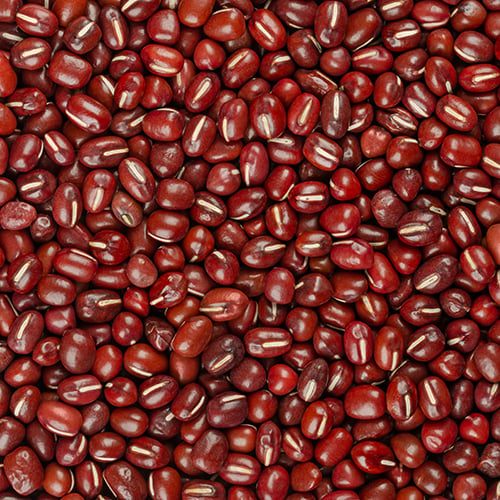
18. Adzuki Beans
Adzuki beans are small and round with a bright red color. Popular in Chinese and Japanese cuisines, they are commonly used to make a sweet red bean paste called anko that is used to fill mochi, cakes, and other desserts or even flavor ice cream and shaved ice. Adzuki beans are also used in a variety of savory dishes like rice and beans, curries, soups, and hummus.
Adzuki Bean Flavor: Nutty and sweet
Adzuki Bean Texture: Soft and firm
Adzuki Bean Uses: Bean paste for desserts, hummus, soup, and side dishes
Beans come in both canned and dry forms, and the choice of which is better for your menu comes down to convenience and desired flavor. While there is some slight nutritional variance, both canned and dried beans are high in fiber, protein, and a wide variety of vitamins and minerals, making both a healthy addition to any recipe!
Canned Beans
Canned beans come conveniently pre-cooked, which means there is no need for overnight soaking, so it effectively reduces the time it takes to prepare them while still being healthy and nutritious. However, beans may lose some nutrients during the canning process and they are packaged with additives, including high amounts of sodium, to preserve them. If you use canned beans, rinse them before use to reduce the amount of sodium added to your meals.
- Come pre-cooked to reduce the time it takes to prepare them
- Easier to store
- Provide a convenient alternative to dried beans while still remaining healthy and nutritious
- Packaged with high amounts of sodium
- Cannot control the texture of the beans
- Some nutrients may be lost in the canning process
Dried Beans
Dried beans allow you to control the taste, texture, and firmness of the beans, so you can have complete control over your recipes and deliver the freshest taste. They are unprocessed so their nutritional value is completely intact, but they need to be stored correctly in order to preserve their quality. While dried beans are a more cost-effective option, they do take more time and effort to prepare and typically require overnight soaking before cooking.
- Deliver a fresher, more flavorful taste
- Can control the texture and firmness of the beans
- Most cost-effective option
- Unprocessed and more nutritionally dense
- Take more time and effort to make; usually require overnight soaking
- Are susceptible to pantry bugs and mold if improperly stored
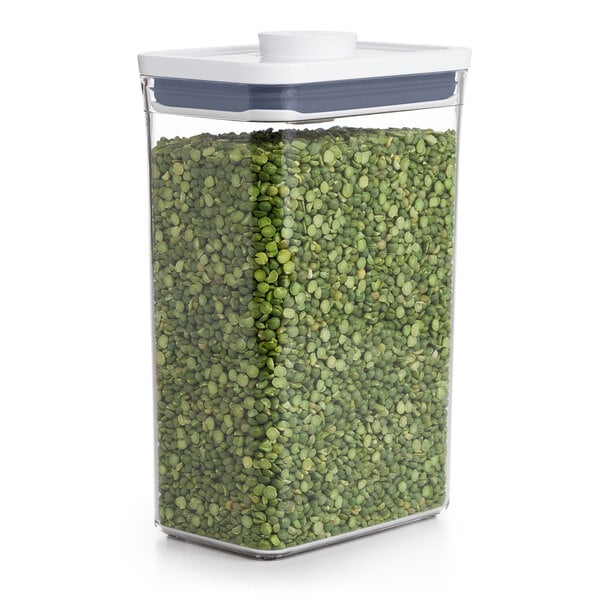
Dried beans should be stored in a cool, dry place in an airtight container to keep out unwanted moisture, mold, and pantry bugs. Alternatively, you can store them in the freezer inside a freezer bag to protect them from heat, light, and insects.
How Long Do Dried Beans Last?
If properly stored, dried beans last 2 to 3 years before they begin to lose their nutritional content, with most of the nutrients completely gone within 5 years. However, your stored beans should be safe to eat indefinitely as long as there are no signs of pantry bugs, mold growth, or unusual smells.
Read on to learn the answers to some frequently asked questions about beans.
How Many Types of Beans Are There?
There are approximately 400 types of edible dry beans that are grown around the world. They are a staple food in many cuisines, especially Central and South American and African diets.
What Beans Go in Chili?
The three most popular beans for chili are kidney, pinto, and black beans due to their earthy flavor and firm, yet creamy texture.
What Are White Beans?
White beans are a group of legumes with a white exterior and a generally soft, creamy texture. The types of white beans are great northern beans, cannellini beans, navy beans, and lima beans. Despite the different varieties having slightly different flavors, textures, and sizes, they can be used interchangeably in recipes.
Can You Freeze Baked Beans?
You can freeze baked beans, and any other type of cooked beans, in the freezer for up to 6 months. Store the cooked beans in an air-tight container and let them cool completely before freezing. Be sure to leave some space at the top of each container to allow any liquid to expand as it freezes.
Use the types of beans chart below as a guide to reference the 18 most common types of beans and their flavor profiles.
Related Resources

Types of Lentils
You might be under the impression that lentils are a boring health food with a bland taste. Not true! These nutritious legumes are certainly healthy, but they're full of flavor too. Lentils are packed with protein, they're a great source of fiber, and they help to boost the nutritional value of your plant-based dishes . Not to mention, they cook up more quickly than beans and are easier to digest for most people. We'll introduce you to the most popular types of lentils and explain what makes each kind unique so you can use them correctly in your recipes. Shop All Lentils What Are Lentils? First of all, what is a lentil? Is it a type of bean ? Not quite. Lentils are not beans, but they both come from the same type of plant. Lentils, beans, p

Different Types of Greens
It's no surprise that leafy greens are an important part of a well-balanced diet. They are full of essential vitamins and minerals that offer a variety of health benefits. They can also be easily incorporated into a wide range of meals to add depth and balance to a dish. We made a list of some leafy greens you may want to try growing in your culinary garden this year to spruce up your menu. Shop All Vegetables Use the following links to navigate and learn more about each type of leafy green: Kale Arugula Bok Choy Spinach Collard Greens Cabbage Romaine Lettuce Watercress Sorrel Swiss Chard Endive Escarole Microgreens Mustard Greens Turnip Greens Beet Greens Radish Greens Broccoli Rabe Kohlrabi Greens Dandelion Greens Printable Infographic Ty

Traditional Hispanic Food
Hispanic cuisine has become increasingly popular among Americans, capturing their hearts and appearing on menus across the nation. Dishes like tacos, quesadillas, tres leches cake, and margaritas are classic crowd favorites. However, amidst this widespread appreciation, there are still numerous authentic Hispanic dishes that may not be as familiar to you. To pay homage to the diverse culture and heritage of Spain, Mexico, the Caribbean, Central America, and South America, consider celebrating National Hispanic Heritage Month in your restaurant with some of these traditional Hispanic foods! Shop All Hispanic Foods When Is Hispanic Heritage Month? Hispanic Heritage Month begins on September 15, 2023, and lasts until October 15, 2023. The reas
- Topics 1346
- Industrial 55
- Troubleshooting Guides 21
- Restaurant Management 128
- Bar Management 55
- Catering Tips 35
- Bakery Management 42
- Food Trucks & Concessions 49
- Advertising & Marketing 37
- Eco-Friendly Tips 11
- Facility Layout & Design 41
- Coffee Shop Tips 28
- Installation & Maintenance 51
- Janitorial & Pest Control 30
- Safety & Sanitation 88
- Startup Tips 104
- Menu Design 10
- Kitchen & Cooking Tips 81
- Hospitality Management 23
- Pizza & Sandwich Shop Tips 36
- Smallwares 37
- Food Prep 88
- Tabletop Items 17
- Disposables 22
- Calculators & Tools 6
- Consumables 52
- Warewashing & Laundry 18
- Cooking Equipment 90
- Food Storage & Refrigeration 51
- Beverage Equipment 34
- Office Supplies 6
- Resource Type
- In-Depth Articles272
- Buying Guides296
- How-Tos93
- Product Reviews77
